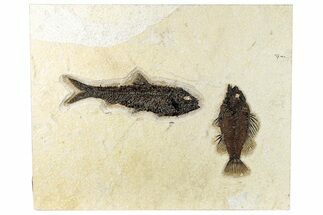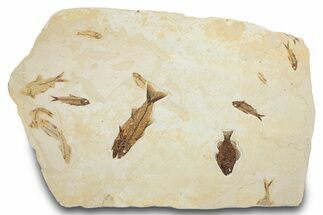This Specimen has been sold.
Double Priscacara Liops From Wyoming
This is a very aesthetic fossil fish plate from Wyoming. It has two similar sized Cockerellites liops naturally associated next to each other. The plate is approximately 16x7 1/2 inches and has been backed with plywood both to stabilize it and make it easier to mount.
The plate comes from "18 inch layer" of the Green River Formation near Kemmerer, Wyoming. Fish from these layers are much darker in color than the more common "split fish" and completely buried underneath the surface of the rock when collected. Preparing a plate like this would have required many hours of tedious work under magnification. You won't see many plates more displayable than this for sale.
The plate comes from "18 inch layer" of the Green River Formation near Kemmerer, Wyoming. Fish from these layers are much darker in color than the more common "split fish" and completely buried underneath the surface of the rock when collected. Preparing a plate like this would have required many hours of tedious work under magnification. You won't see many plates more displayable than this for sale.
Cockerellites liops is a species of extinct temperate bass found in the Eocene aged Green River Formation of Wyoming. It is characterized by a sunfish-like body and its stout dorsal and anal spines. It was originally placed in the Priscacara genus but was moved to the newly created genus Cockerellites by D. Jordan and H. Hanibal in 1923. There is still some debate among researchers about whether this new genus is valid.
Cockerellites is found in large numbers in mid-lake deposits, representing 5 to 20 percent of the fish unearthed, depending on the layer. It is considerably rarer in shoreline deposits, representing only 1 to 2 percent of the fish found. Because of this, Cockerellites is thought to have been a schooling fish. Fossils have been found at a maximum size of about six inches, but they rarely exceed five inches in length.
At first glance, Cockerellites liops has a very similar appearance to the rarer species Priscacara. Size can often be used as a differentiator, since Cockerellites did not exceed 6 inches while Priscacara serrata is typically found in excess of 6 inches. Cockerellites also has more dorsal and anal fin rays than Priscacara and a much smaller mouth.
Cockerellites is found in large numbers in mid-lake deposits, representing 5 to 20 percent of the fish unearthed, depending on the layer. It is considerably rarer in shoreline deposits, representing only 1 to 2 percent of the fish found. Because of this, Cockerellites is thought to have been a schooling fish. Fossils have been found at a maximum size of about six inches, but they rarely exceed five inches in length.
At first glance, Cockerellites liops has a very similar appearance to the rarer species Priscacara. Size can often be used as a differentiator, since Cockerellites did not exceed 6 inches while Priscacara serrata is typically found in excess of 6 inches. Cockerellites also has more dorsal and anal fin rays than Priscacara and a much smaller mouth.
SPECIES
Cockerellites liops
LOCATION
Kemmerer, Wyoming
FORMATION
Green River Formation
SIZE
Both fish 4.8" long, plate 16x7.5"
CATEGORY
SUB CATEGORY
ITEM
#1325
We guarantee the authenticity of all of our specimens.
 Reviews
Reviews












